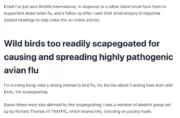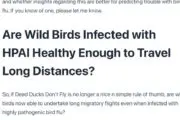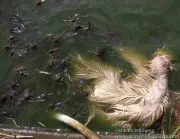Dead Ducks Don’t Fly: Wild Birds not Major H5N1 Vectors
[See also my page on info and links re bird flu, esp the New n Nasty H5N1 Variant; also, a forum thread on this site, on H5N1 avian flu and migratory birds: posts welcome.]
Migratory birds, especially waterbirds, carry several forms of bird flu. This H5N1 Bird Flu Variant has spread rapidly in east Asia. Birds migrate, with migration routes linking infected countries. Ergo: migratory birds are responsible for the spread; or “likely” to be responsible, or “presumably” (Klaus Stohr, WHO), and other such less emphatic terms. [The WHO’s 2 March 2004 update says there’s no evidence for this. Better late than never!]
This makes for a nice, easy story, with wild birds making easy targets (scapegoats): they don’t vote, don’t speak, aren’t even perceived as having great value. But take a little time to seek truth from facts (thanks, Deng Xiaoping, for pithily summarising a basic tenet of science), and the story looks just plain wrong – making it unjustified to make wild birds seem scary, or even suggest culling wild birds, as some people have done. The timings of the outbreaks and bird migrations are wrong; detailed migration routes and distributions are wrong; the new variant is lethal to wild birds too – it has killed some, but though thousands of evidently healthy wild birds have been tested, none (or only one) has yet been found to be carrying the new and nasty H5N1 variant (Genotype Z).
Update, 28 May 2005: with a thousand bird deaths reported in Qinghai, northwest China, migratory birds are again in the spotlight.
But, where did the virus killing them originate?
Flus, Bird Flus, and the Nasty H5N1 Variant
There’s no denying wild birds host flu; some 15 basic forms (strains) have been discovered. Ducks and geese are the main birds that flu viruses have been found in – maybe that’s not surprising given they’re prone to congregate for long periods and live on open water and marshy grasslands, and the fact that in them, the viruses transmit via faeces. But these natural viruses seem to have little impact on wild birds (till recently, the only incident known when bird flu caused extensive wild bird deaths was amongst common terns, in South Africa in 1961).
The flu viruses can change, however, if they infect chickens. Chickens – descendants of forest-dwelling red junglefowl – maybe never had bird flu naturally. Put them near domestic ducks, some of which may have bird flu or could catch it from wild birds, and there’s a chance the virus can infect them, crossing the “species barrier”.
Then, it’s possible at least some of the chickens will fall sick and die with bird flu, or avian influenza or fowl plague as it’s also called, first (scientifically) described in Italy in 1878, but reportedly known in China for centuries. Two basic “families” of bird flu, H5 and H7, may cause sickness and death – and are then termed highly pathogenic avian influenza. But they may be relatively harmless at first: flu viruses readily mutate, which means that once in a new host, a strain can rapidly evolve, increasing its ability to survive and multiply. The now infamous H5N1 is among these: many variants have been isolated many times, some are non-pathogenic, some highly pathogenic; it’s prone to readily mutating.
These evolving virus strains can devastate poultry flocks; the only way known to eradicate them is to slaughter all infected chickens. Eradication efforts have evidently proven successful, such as in the US in a 1983-84 outbreak, and in the Netherlands in 2003 (when a strain of H7 – H7N7 – even infected 84 humans, killing a veterinarian).
It’s unusual for flu to transmit directly from chickens to humans; the first documented cases were in Hong Kong in 1997, when a variant of H5N1 infected 18 people, killing six. Chickens were slaughtered in Hong Kong (and neighbouring Guangdong province), and in Hong Kong at least, it seemed the eradication efforts had been successful. But the variant – which was new to science – wasn’t defeated.
The variant (actually, close relatives! – H5N1 is a slippery customer, not surfacing in forms that are readily categorised as “variants” or whatever) reappeared in Hong Kong, including in 2002. Early that year, there were outbreaks in chicken farms, leading to over 100,000 chickens being destroyed; and a trial vaccination programme began. Though some doubt vaccination wise for bird flu control, partly as apparently healthy birds can host and shed virus, this programme has since been expanded. In December that year, there were outbreaks in two public parks, killing ornamental (captive) ducks, geese, swans and greater flamingos; at least one wild little egret died of the virus at one of these parks; two other wild birds – a grey heron and a black-headed gull – were found dead elsewhere in Hong Kong and tested positive for H5N1; as did a peregrine falcon, found in a Hong Kong Island park, looking nervous, as if abandoned by its owner.
Based on the above, wild birds were determined responsible for the outbreaks in the parks. Hong Kong’s Secretary for Health, Welfare and Food, Dr Yeoh Eng-kiong, blithely remarked at a subsequent press conference, “Of course, we had incidents where migratory birds had brought some infections to some of our birds in the Penfold Park.” This despite the fact most of Hong Kong’s little egrets are year-round residents; and no one knew just how the wild birds came to be infected. (Soon after these outbreaks, H5N1 was again discovered in local poultry farms.) And while wild waterbirds are relatively uncommon in these parks, they are abundant at the internationally important Deep Bay wetland in northwest Hong Kong – which in winter hosts around 50,000 gulls, ducks, shorebirds and other waterbirds: yet the birds there remained healthy.
Yeoh skipped mention of concerns vaccinating may mask, even increase, problems in poultry, making wild birds seem the only problems: “We are now vaccinating all our [domestic] birds in Hong Kong so that the risk of infection is much lowered. So migratory birds are problems and we will always have the risk of avian flu in Hong Kong. “
To date, the Penfold Park outbreak remains the only instance in which wild birds are purported to have been the source of this H5N1 variant.
The Difference is in the Timings
Light relief at last! – in the form of this map (here’s hoping the folks in the Australian Wader Studies Group don’t take umbrage with me for making use of their East Asian-Australasian Flyway map).
I hope this will help show why it’s ridiculous to blame the rapid spread of the H5N1 variant on east Asia’s migratory birds. The gist of the argument is summarised on the right of the figure – birds wintering in the south had departed South Korea and Japan before their outbreaks began; hadn’t even arrived in southern areas (especially Indonesia) as outbreaks began there. And China – crossroads for most of the migration routes – didn’t even report outbreaks till January, well after the autumn migration had ended.
Further, the chief bird flu hosts – ducks and geese – mainly winter towards the north of the region. Geese, especially, are hardy birds, rare south of central China. Ducks reach the south China coast, including Hong Kong, in numbers, but ducks from elsewhere head to Thailand; and all northern ducks are rare in Indonesia.
Shorebirds travel the longest distances of all the waterbirds (excluding seabirds, which don’t seem relevant). Yet their migration timings also don’t fit those of the outbreaks, nor do their distributions – plus many are found on coastal estuaries and beaches, ie away from farms.
In the west of the area are openbill storks, which nest at a few colonies in Thailand, during winter. Some died this winter, and even before testing positive for H5N1 (which was reportedly identified in three carcasses) this incident was taken as evidence for migratory birds spreading bird flu: notably by New York Times journo Keith Bradsher. Trouble is, they migrate from Bangladesh/ne India; and they feed in fields within one of Thailand’s worst-hit regions – making it surely the case that local poultry farms were the source of the virus; they were victims.
The migratory-birds-are-to-blame case crumbles even further when you consider that thousands of migrants have been tested for H5N1, yet not one healthy bird has yet tested positive. All wild birds that have tested positive have been dead (or dying). And dead ducks don’t fly.
Bird flu – highly pathogenic avian influenza articles
On highly pathogenic avian flu issue, Birdlife should be voice of wild birds not defer to poultry industry
Email I’ve just sent Birdlife International, in response to a rather bland email from them to supporters about avian flu, and…
Spread of Guangdong goose highly pathogenic avian influenza in poultry farms and wild birds
Wild birds can be readily blamed for spread of highly pathogenic avian influenza, while investigations of poultry trade sparse by comparison.
Highly pathogenic bird flu variants mostly evolve in intensive poultry farming
Highly pathogenic bird flu variants evolve from regular, low pathogenic, bird flus, within intensive poultry farming.
Bird Flu inc H5N1 Info
Info and links re bird flu, especially the nasty H5N1 variant in Asia
See also forum on this site: H5N1 Poultry Flu and migratory birds




